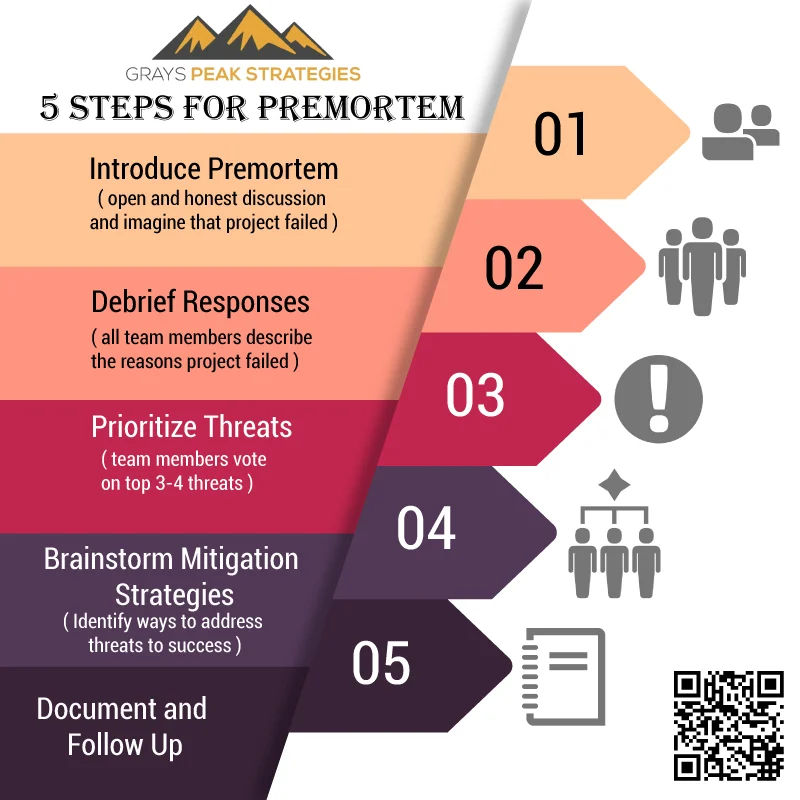An Ounce of Premortem is worth a Pound of Success
Maureen Leif, President and Founder of Grays Peak Strategies
It is always nerve-wracking to be responsible as the manager of a big project knowing how many projects never succeed. A critical part of successful project management is to assess the risk at the beginning of the project. One way to do that is called a premortem analysis. This does not sound like something fun since mortem means death. In a nutshell, the project team comes together at the beginning of a project and performs an interactive discussion assuming it’s the end of the project and that the project or organization has failed. The team then works backwards to figure out what lead to the failure and how to mitigate the danger. There are many benefits to a premortem which include providing a safe environment in which threats to the project can be openly discussed without fear of the speaker being seen as negative. The reverse of a premortem is, of course, a post-mortem which means looking at the project at the end and analyzing which pieces of the project were successful and which were not.
Gary Klein developed the project premortem and published the process in the Harvard Review in 2007. The idea was based on a post-mortem on a patient, wherein an autopsy is performed to find the cause of death. A post-mortem certainly does not help that particular patient. Premortem analysis has been studied and shown to be successful in increasing the ability to correctly identify reasons for future outcomes by 30%.[1] As a project manager if you are 30% more informed about threats to the project success, you are well on your way to being able to mitigate those threats and be successful.
The premortem approach has been successful on many of my projects with the Judicial Department. In my experience there are usually threats that people close to the project are aware of, however, they do not want to be perceived as a negative team member so they concentrate on the positives of the project. A colleague and I performed a live mock premortem analysis at a Western Interstate Child Support Enforcement Council (WICSEC) Conference in 2015. The audience gave us a sample project that someone was getting ready to start and the participants walked through all the reasons her project could fail and then brainstormed, as a group, ways that she could mitigate against those threats. At the conclusion, the project manager indicated that people had thought of threats that she had not thought of and that having a brainstorming session was very helpful. Several people in attendance commented that they would like to take this approach back to their project teams.
There are 5 simple steps to do a project premortem:
1. Introduce Premortem
Explain what a premortem is and the goal of the exercise. Give your team members permission to be open and honest. Give some examples and describe the process. Hand out an instruction sheet with the questions you want answered at the top with room to take notes. (example: Imagine that we are at the end of this court and child support data exchange project and even though we are all amazing, our project has failed. We need to come together to figure out where we went wrong. Work individually and spend 10-15 minutes brainstorming the reasons our project has failed.
2. Debrief Responses
Go around the room and have the team members describe the reasons that they came up with. Have someone scribe the responses on a flip chart or projector, so that everyone can see.
3. Prioritize threats
The team should choose how they would like to prioritize. They can vote, or discuss until consensus is reached, turn in a paper ballot, voting sticker dots given to each member to place on the flip chart near their highest priority, etc.
4. Brainstorm Mitigation Strategies
Go through the top 3-5 threats identified and brainstorm with the whole team items that can be done at the beginning of the project to ward off potential sources for failure. Indicate responsibilities and action items for identified mitigation strategies.
5. Document and Follow UP
The project team should decide how the threats are incorporated into the Project Plan and who is responsible for tracking. The project team should all meet as a group post project kickoff and discuss the priority items identified.
If you are interested in more information or speaking with someone to facilitate a premortem for your project or agency, please contact us.
[1] Article, “Performing a Project Premortem” By: Gary Klein, Harvard Business Review, September 2007. https://hbr.org/2007/09/performing-a-project-premortem

